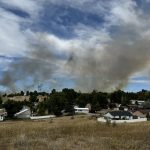Tom Ross: The eyes of Texas are upon you
Greetings to all from the extreme northern region of the Republic of Texas
Steamboat Springs — Editor’s note: This Tom Ross column originally appeared in the Jan. 30, 2005, Steamboat Today.
Have you ever stopped to think what life would be like if Steamboat Springs were in Texas?
I mean it literally – what would things be like here if the boundaries of the state of Texas were expanded to include the Western Slope of Colorado? For starters, our highways would be in better condition. Let’s see – the Yampa River instantly would become one of the top 10 trout streams in all of Texas, but we would need to purchase an out-of-state fishing license to go over the mountains and fish the Big Thompson. On the other hand, our sons and daughters would be eligible for in-state tuition at Texas A&M – go Aggies – I think. Our state legislators would rack up considerable frequent flyer miles commuting between home and the state capitol in Austin. Our state bird would be the mockingbird, a songbird rarely known to frequent the Yampa Valley. Even worse, the columbine would have to move over and make room for the new state flower – the bluebonnet. Now that just ain’t right.
And it’s a good bet that at this very moment, Gov. Rick Perry would be working on a plan to divert water from the Gunnison River to Amarillo. Of course, I know some of you already are thinking, “This is preposterous!”
And my response would be, “You’d better think twice, armadillo breath.” Thanks to a vigilant reader, I have been provided with hard evidence that the land where our fair city sits today once was part of the Republic of Texas, a sovereign nation. Furthermore, our sources tell us that there are still people in Texas who reject the notion that Texas was annexed to the United States of America on Feb. 19, 1846.
Steamboat history buff Don Valentine visited me at my office recently and showed me a reproduction of a map of the Republic of Texas circa 1845, roughly one year before the republic became part of the United States. The outline of the map is recognizable as the state of Texas we know today, but with some notable exceptions.
Extending north from the Rio Grande River where it flows out of Colorado’s San Juan Mountains and through present-day Alamosa is a chimney of land that runs straight through some of your favorite ski areas.
From the familiar names of rivers and some mountain ranges, I can see that this former portion of the Republic of Texas encompassed Mount Crested Butte, Aspen, Vail and Steamboat. Kind of makes you wonder if they were speculating on ski town real estate, doesn’t it? The map of the Republic of Texas doesn’t end at Colorado, either. It continues north, following the North Platte River past the Medicine Bow Range and the Sierra Madres, taking in what is now Encampment, Wyo. At one time, the Republic included 251 million acres and parts of New Mexico, Kansas and Oklahoma. Closer to home, the map points out the Flat Tops, Rabbit Ears Pass and the West Elk Mountains. Clearly visible on the map, inside Texas territory, is the big bend to the west described as the Yampa River at Steamboat Springs.
So, it’s safe to say that you woke up this morning in a bed, in a house on a plot of land that once lay within the Republic of Texas. How does that grab you?
The Republic of Texas formed during the same time period as the legendary siege of the Alamo – the constitutional convention was convened March 1, 1836, and the Alamo fell March 6.
The Republic’s first president, Sam Houston, and Mirabeau B. Lamar after him, were struggling to keep the fledgling Republic of Texas out of debt in the early period, and ultimately welcomed annexation to the United States. Later, portions of Texas were split off.
However, the spirit of the Republic of Texas lives on. Any woman older than 16 who can document that she descends from a line of ancestors who were pioneers or soldiers who helped the Republic through its conduct is eligible to join the Daughters of the Republic of Texas. It’s an organization founded in 1891. Its members have built and conserved a library of historic documents that preserve this period in American history. And they still celebrate that history today.
At the other end of the spectrum, there remains a movement in Texas of individuals who seek to invalidate the annexation of 1846. They staged a “rebellion” in the Davis Mountains of West Texas in 1997, and as recently as 2003, separatists in the East Texas town of Overton rented a 16,000 square foot building for the purposes of setting up a “provisional government” for the revived Republic of Texas. They went as far as offering to issue passports to visitors. If you don’t think the movement exists, visit its Web site at http://www.republic-of-Texas.net. People on Colorado’s Western Slope can identify with a movement that sometimes wishes it could separate itself from state government. And it’s a fact that the Steamboat Ski Area would not be what it is today if it weren’t for the millions invested by Dallas aerospace company LTV-RDI back in the ’70s.
But if it’s all the same to you, when the Republic of Texas rises again, would you mind leaving Steamboat out of it? We love Texans, but we like our green-and-white license plates. And besides, the notion of heading out west to ski the “Texas Rockies” just doesn’t have the same ring to it.

Support Local Journalism

Support Local Journalism
Readers around Steamboat and Routt County make the Steamboat Pilot & Today’s work possible. Your financial contribution supports our efforts to deliver quality, locally relevant journalism.
Now more than ever, your support is critical to help us keep our community informed about the evolving coronavirus pandemic and the impact it is having locally. Every contribution, however large or small, will make a difference.
Each donation will be used exclusively for the development and creation of increased news coverage.









